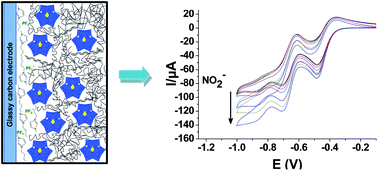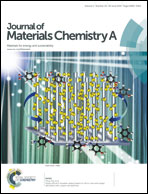Interfacing a heteropolytungstate complex and gelatin through a coacervation process: design of bionanocomposite films as novel electrocatalysts†
Abstract
Bionanocomposite films on glassy carbon electrodes (GCEs) have been prepared by a very straightforward and reliable method based on a layer-by-layer deposition of polyoxometalate (POM) (i.e. [BW12O40]5−) and gelatin solutions. The strong immobilisation of [BW12O40]5− on the surface of the GCE results from electrostatic interactions between gelatin and POM, as evidenced in a hybrid hydrogel prepared by a coacervation process. The GCE has also been modified by imidazolium based ionic liquids in order to increase the charge transfer rate. Two modified electrodes with one or two POM layers have been prepared by this strategy. When compared to other POM-based modified electrodes, the novel electrodes with two POM layers exhibit excellent electrocatalytic performance for nitrite detection at pH 3 in terms of sensitivity (868 mA M−1 cm−2) and linear range of nitrite concentrations (50–600 μM).


 Please wait while we load your content...
Please wait while we load your content...